
Photo from wikipedia
Land use and land cover change (LULCC) is one of the main components of current anthropogenic global change. Unravelling the ecological response of biodiversity to the combined effect of land… Click to show full abstract
Land use and land cover change (LULCC) is one of the main components of current anthropogenic global change. Unravelling the ecological response of biodiversity to the combined effect of land use change and other stressors is essential for effective conservation. For this purpose, we used co-inertia analysis to combine LULCC analysis of earth observation satellite data-derived maps and raptor data obtained from road censuses conducted in 2001 and 2014 at sampling unit level (10 km2 spatial resolution), in northwestern Spain (province of Ourense, c. 7281 km2). In addition, habitat suitability models were also computed using ten widely used single-modelling techniques providing an ensemble of predictions at landscape level (four spatial resolutions: 500-m, 1-km, 2-km and 5-km radius around each sighting) for each year and raptor species to analyse the habitat suitability changes in the whole study area through three niche overlap indices. The models revealed an increase in occurrence and habitat suitability of forest raptor species coupled with a strong decrease in species associated with open habitats, mainly heaths and shrub formations. Open-habitat specialist species were negatively affected by the concomitant effects of intensive forest management and a long-lasting trend of rural abandonment coupled with an unusually high frequency of wildfires. Sustainable forest management and agricultural practices should be encouraged by both public and private sectors, through, e.g. policies related to European funds for rural and regional development (FEDER and FEADER programs) to effectively protect threatened habitats and species, and to comply with current environmental legislation. The combined use of satellite imagery and ground-level biodiversity data proved to be a cost-effective and systematic method for monitoring priority habitats and their species in highly dynamic landscapes.
Journal Title: European Journal of Wildlife Research
Year Published: 2017
Link to full text (if available)
Share on Social Media: Sign Up to like & get
recommendations!